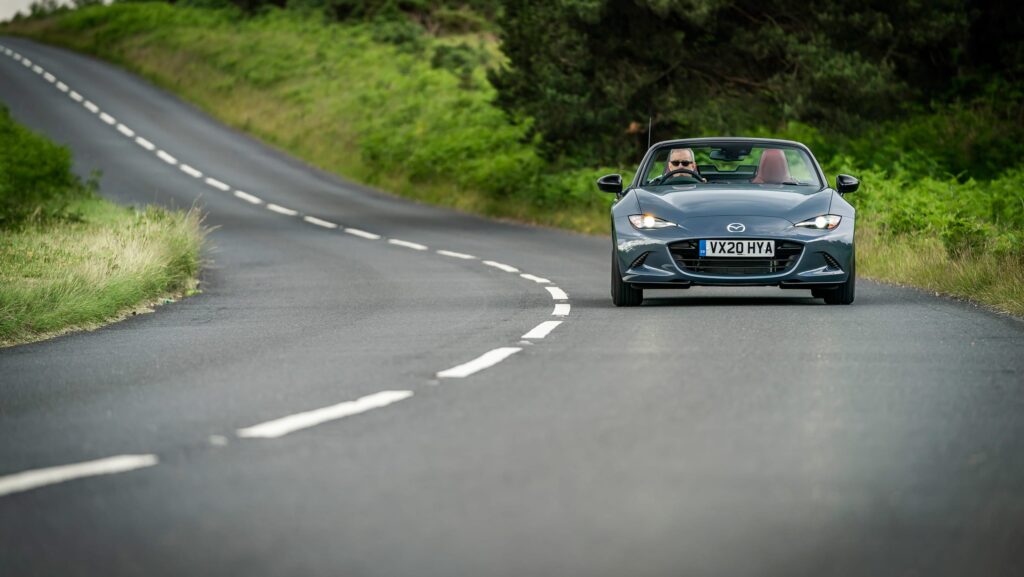Small. Simple. Light. Those are words most people don’t use to describe vehicles on the road today. Lately however, I’m starting to see this quickly shrinking and forgotten segment of the car market is where the real fun lies.
Personally, I’ve been going for steadily more powerful and advanced cars in the search for something more entertaining, but I’ve come to the realization my aspirations may have led me in the wrong direction. Powerful cars require big engines and often include electronic wizardry to make the power usable and keep the rubber side down. That means a heavy car with aviation-grade electronics isolating you from the driving experience. Is that really where the true driving fun is found? I’m starting to think the answer is, “no”.

The pivotal moment
What made me question everything I valued in a performance car? A simple, unexpected event. Recently, I drove a 2010 Mazda3 S hatchback I gave to a family member many years ago. I was really surprised by how fun it is to drive. The car is nimble and playful compared to my BMW 435i. Hydraulic steering and a curb weight of barely 3,000 lbs has a lot to do with it when compared to a 3,600 lb car with electric steering, but there is something else. The Mazda is a simple car. No heated or ventilated seats, adaptive suspension, or forced induction on the engine. The only tech feature is basic Bluetooth audio and hands free calling. The car is a simple, manual transmission hatchback with nicely tuned steering and suspension. There is nothing to mute or isolate the driver from car or the road.
The humble second generation Mazda3 is a car you put on. Steering is tight, precise and direct. Good ergonomics put the shifter, steering wheel, and the pedals all in the perfect place. The six-speed transmission is geared so you can take advantage of all 156hp from the 2.5L engine. I found myself effortlessly darting around the backroads and maneuvering through traffic on the highway as if by instinct. I was Tony Stark and the Mazda was the Ironman suit….um….OK…not really, but you get the idea.

The brief drive in the Mazda3 stuck with me and brought back few of my most memorable driving experiences. Three stuck out
- Bombing along English B roads in my E46 BMW 323i
- A spirited drive along those same English backroads in a Mini One (UK only model at the time)
- Blitzing Ozark backroads in my Mk6 GTI
What do those experiences all have in common? Small, light cars with only the basic amenities.
Small
Do you want to feel like you’re strapping on a car rather than simply climbing aboard? You can’t beat the feel from any small, light car. A short wheelbase allows a car to rotate easier giving it a fun, tossable, nimble feel and the small size puts you right in the middle of the driving experience in ways you can’t experience in any larger vehicle.
Size also plays a big part in how easily a driver can place a car exactly where they want it. Small size not only offers better visibility, but it allows the car to be maneuvered in ways a large car simply cannot. On the hilly backroads where I go to “play”, the lanes are narrow, turns are tight and frequent. There are no shoulders and trees grow right to the edge of the traffic lane. Those roads are the last place you want a long and wide vehicle. Even in urban traffic, a smaller car provides a far better platform to easily move through traffic or even park. Many fear being squashed by the gigantic SUVs and trucks which dominate the roads today, but small size and excellent agility provide a great advantage in keeping out of the way of those lumbering beasts.
Simple
In a world becoming more tech-laden every day, there is a refreshing purity to be found in driving a car which leaves elaborate features and technology behind in an effort to deliver focused driving experience.
Lets be honest. An enjoyable driving experience has nothing to do with messaging seats, navigation systems, color changing interior ambient lighting, or giant touch screen infotainment systems. Those things drive up cost, weight, and complexity of the car and only serve as a distraction. Simple, easy to read buttons or switchgear for the basics like climate control, headlights, wipers and a radio with smart phone integration is all we need. Ok…I’ll freely admit to be addicted to heated seats. We’ll add that to the list of “needs” since they can greatly expand the comfort of driving a fun car well into the colder seasons.
Do I even need to mention the driving aids, a.k.a “nannies” that fill up today’s vehicles? Ugh. It is getting out of hand. The topic is a minefield, but here’s what I think. Things like ABS and traction control are helpful when calibrated to not intrude into the driving experience, and even blind-spot monitoring aids aren’t bad for cars with poor visibility. I draw the line at most/many of the lane keeping and auto breaking systems found today. Frequently they don’t work properly and a driver often finds themselves fighting against them in normal driving let alone driving one in a fun environment like a backroad run. If you have to constantly turn it off, it needs to go away.
Light
No discussion on vehicle lightness is complete without quotes from the great Collin Chapman; founder of Lotus Cars and champion of great driving cars.
“Simplify and add lightness”
“Adding power makes you faster in the straights. Subtracting weight makes you faster everywhere.
Colin Chapman
Truer words have never been spoken. No matter how big or powerful a car, subtracting weight never made it perform worse. Track days and HPDE’s are rife with tales of a massively powerful vehicle who couldn’t shake an Elise, Miata, or Cayman off their tail. The driver might gain space on a long straight, but at the next sequence of turns the sprightly little car is right on their tail or even making a pass. The ability for the light car to effortlessly carry speed through corners is a huge advantage and will make you smile every time.
Weight is the enemy of agility. Regardless of weight balance and any black magic and massive tires the suspension engineers use, large amounts of weight will always make it slower to change direction…any direction. You simply can’t outrun physics and packing on pounds will impact the ability to accelerate, corner, turn, and stop.
There is also a largely overlooked practical side to having a light car; consumables like tires and brakes. When driving a fun car hard in any situation puts stress on many areas of a car, but those which will wear faster than anything else are tires and brakes. Take a big car like a Dodge Challenger, Ford Mustang, or BMW M4 to a track day and it isn’t unusual to completely wear out a set of tires and brake pads in a single event. The drivers of the Miata’s, Elise’s, BRZ/86’s, and Miata’s often run multiple events or even an entire season of events on a single set. This equals many more smiles and miles for far less money.
What about power?
OK, I’m going to walk carefully through this minefield. Some feel a car needs to be over some arbitrary number to even be worth considering. It must have more power than anyone else! There is a reason 1000hp hotrods exist and your Dodge has built their entire brand from dropping gigantic fire-breathing V8’s into everything they build (and loaned them to others like Jeep). On the other hand some enthusiasts simply don’t care and are looking for a go-kart like car they can toss around a backroad with the engine at full wail.
The numbers game
Where do I stand? I really don’t get hung up horsepower numbers because they are only one metric. Many people often see it as a discriminator and I’ve heard comments like, “I won’t even consider a car under X horsepower. That’s too bad. Previously, power was very important to me as I hunted a huge surge of acceleration when I mashing the gas pedal. However, after my reunion with the Mazda3 and a recent test drive of a Mazda Miata, I’ve started to realize the joy found in a small tossable car with less power…even if you can’t always outrun that family of five in a Honda Odyssey who won’t let you merge onto the highway.
How does it feel?
The real measure is how the car feels. How a car puts down power and delivers torque goes a long way towards making a lower power car feel and actually perform like it has more to offer. A light car with a engine tuned to put down torque at the right place in the powerband will make it accelerate better and be faster in certain situations than simple 0 – 60 or horsepower numbers might imply. This also goes back to weight. A small, light, car will take far less power to make it properly quick than a heavier car.
The ability to apply the power has a big impact on feel and determining whether what is available is adequate. Dropping huge engines in a tiny car might be good for a few laughs, but having to constantly feather the throttle to keep the wheels from spinning or inducing over steer or even having to deal with understeer due to the additional engine weight isn’t much fun. A rev-happy engine which pulls smoothly across the entire rev range and responds rapidly to throttle inputs is really entertaining to drive in just about any conditions.
Can you use it all?
My BMW 435 is the most powerful car I’ve ever owned. At 350-ish horsepower, it’s merely respectable in the world of average performance cars, but I still find very few places to utilize all the available power. The power is handy when driving on highways and trying to get through traffic, but nothing I couldn’t do with a less powerful car. On backroads, I’ll never come close to using all the power the car has available. The straights are too short and the tight, twisty turns demand slower speeds. Going wide open throttle in a powerful car on those roads is a one-way trip into the trees or into the cones at autocross.
With less powerful car, I find it far more entertaining to wring out every last ounce of horsepower; from idle to redline. Blasts to redline are much easier to squeeze in to the course of a regular drive. Knowing the powerband of the car becomes crucial, and from there driving simply becomes a game of how to keep it there. On a nice backroad you can rip all the way to the redline in the lower three gears most of the time. The full potential of the car, both powertrain and suspension, are fully available to be used to their maximum potential. If you find yourself in a car with a smooth rev-happy engine like the four cylinder engine found in just about any Mazda product or the one VAG puts in the VW GTI/Golf R, or Audi’s S3, you’re in for a real treat.
Examples
At this point, if you haven’t decided I’m insane and given up reading, you’re probably asking, “what cars is he thinking of?” There are probably more out there than you realize. Here is a quick list based on the US market. Personally, I’d lean towards the rear while drive cars on this list, but I won’t deny the front wheel drivers would be fun as well. Pick your poison.
- Mazda Miata. Any generation. It is the answer, and how can it not be the top of this list.
- The Fiat 124 falls into this category since it is so similar to the ND Miata
- Porsche Cayman or Boxster
- Lotus Elise
- The Toyobaru twins. Toyota/Scion/Subaru FRS/BRZ/86…either generation
- BMW Z3 and maybe Z4 if you get an earlier one with a manual transmission
- Bonus points if you score an M Roadster or M Coupe version
- VW GTI. Reliability really went up with the Mk6
- Hyndia Veloster any generation and especially the new ones with the N package
- Fiat 500 Abarth
- Ford Fiesta ST
- Ford Focus ST
- Civic SI and Type R
- Nissan 350Z and 370Z
- Mini Cooper S and JCW
There are a few additional cars I’d say come close to the ideal, but might fall short by being either a little too heavy or a little too complex. I’ve probably angered many of the readers already, so why not keep going!
- Ford Focus RS
- The new 2022 Nissan Z
- Mk V Toyota Supra
- BMW 2 Series and the M2
- VW Golf R
- Audi S3 and RS3
Wrap up
All this comes down to the underappreciated brilliance of a small, light, performance car you can easily and safely wring out in just about any daily driving situation. While these cars might not rule a road course at an HPDE, they are unmatched fun on a twisty back road. Just don’t try to drag race that minivan on the onramp. Odds are high you’ll loose.
So, what do you think? Agree? Disagree? Am I totally insane or overlook something on list of cars? Let me know in the comments below.

A lot more fun to drive a slower car fast than it is to drive a faster car slow!
Absolutely!